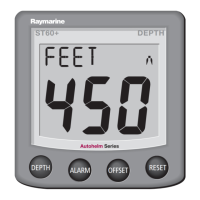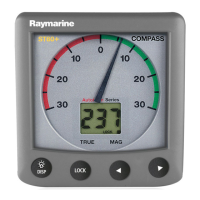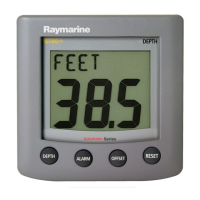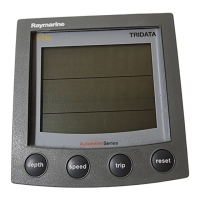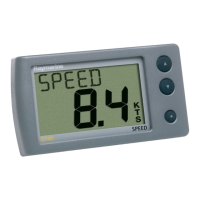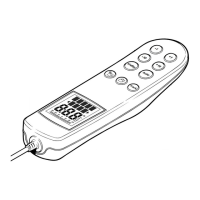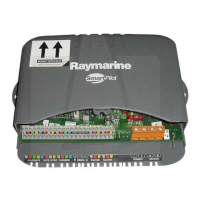Do you have a question about the Raymarine ST60+ SPEED INSTRUMENT and is the answer not in the manual?
Key safety notices, EMC conformance, and handbook information.
Critical warnings regarding installation, electrical safety, and navigation.
Guidelines for electromagnetic compatibility standards and installation.
Notes on accuracy, liability, and product improvement policies.
Requirements for recycling waste electrical and electronic equipment.
Introduction to the ST60+ Speed instrument and its features.
How the instrument receives data and integrates with SeaTalk systems.
Operation mode where the instrument functions independently.
How to control the instrument remotely using a keypad unit.
Different methods for mounting the instrument on a vessel.
List of components included with the ST60+ Speed instrument.
Initial setup, displayed information, and power on/off procedures.
Comprehensive guide to using the instrument's functions.
Accessing current, max, average, VMG, and SOG speed data.
Details on displaying and understanding the boat's speed through water.
Information on viewing and resetting the maximum recorded speed.
Understanding and resetting the average speed calculation.
How to view Velocity Made Good (VMG) data.
How to view Speed Over Ground (SOG) data.
Accessing boat log, trip distance, and water temperature readings.
Using count-up and race-start timers for various timing functions.
Adjusting illumination and contrast for optimal display visibility.
Monitoring autopilot mode and course changes on the display.
Controlling the instrument remotely using a SeaTalk Remote Keypad Unit.
Guidelines for servicing, cleaning, and general care of the instrument.
Important safety precautions and servicing procedures.
Care and cleaning instructions for the instrument itself.
Reference to installation and maintenance instructions for the transducer.
Inspecting and maintaining cables for damage and secure connections.
Steps to diagnose and resolve common issues with the instrument.
Initial checks for environmental factors affecting instrument operation.
Table detailing faults, causes, and remedies for common problems.
Resources for obtaining further assistance and support.
Considerations for transducer and instrument placement, site requirements, and EMC.
Criteria for selecting suitable locations for transducer and instrument fitting.
Details on transducer types and fitting for different hull materials.
Guidance on instrument placement, clearances, and environmental protection.
Recommendations for ensuring optimal electromagnetic compatibility.
How to connect the instrument to other marine electronics.
General steps for unpacking and fitting the instrument and transducer.
Step-by-step instructions for surface mounting the instrument.
Step-by-step instructions for flush mounting the instrument.
Guidance on installing the speed transducer and running its cable.
Wiring and connection types for standalone and SeaTalk systems.
How to connect the instrument to the vessel's power supply.
Initial power-up and basic operation checks after installation.
Overview of calibration importance and procedures for optimal performance.
Setting units, resolution, speed, temperature, and timer buzzer.
Checking software version, instrument status, and performing calibration runs.
Procedure for calibrating speed readings over a measured distance.
Advanced settings for user calibration, response, and factory defaults.
Adjusting the frequency of information updates for speed and VMG.
Key safety notices, EMC conformance, and handbook information.
Critical warnings regarding installation, electrical safety, and navigation.
Guidelines for electromagnetic compatibility standards and installation.
Notes on accuracy, liability, and product improvement policies.
Requirements for recycling waste electrical and electronic equipment.
Introduction to the ST60+ Speed instrument and its features.
How the instrument receives data and integrates with SeaTalk systems.
Operation mode where the instrument functions independently.
How to control the instrument remotely using a keypad unit.
Different methods for mounting the instrument on a vessel.
List of components included with the ST60+ Speed instrument.
Initial setup, displayed information, and power on/off procedures.
Comprehensive guide to using the instrument's functions.
Accessing current, max, average, VMG, and SOG speed data.
Details on displaying and understanding the boat's speed through water.
Information on viewing and resetting the maximum recorded speed.
Understanding and resetting the average speed calculation.
How to view Velocity Made Good (VMG) data.
How to view Speed Over Ground (SOG) data.
Accessing boat log, trip distance, and water temperature readings.
Using count-up and race-start timers for various timing functions.
Adjusting illumination and contrast for optimal display visibility.
Monitoring autopilot mode and course changes on the display.
Controlling the instrument remotely using a SeaTalk Remote Keypad Unit.
Guidelines for servicing, cleaning, and general care of the instrument.
Important safety precautions and servicing procedures.
Care and cleaning instructions for the instrument itself.
Reference to installation and maintenance instructions for the transducer.
Inspecting and maintaining cables for damage and secure connections.
Steps to diagnose and resolve common issues with the instrument.
Initial checks for environmental factors affecting instrument operation.
Table detailing faults, causes, and remedies for common problems.
Resources for obtaining further assistance and support.
Considerations for transducer and instrument placement, site requirements, and EMC.
Criteria for selecting suitable locations for transducer and instrument fitting.
Details on transducer types and fitting for different hull materials.
Guidance on instrument placement, clearances, and environmental protection.
Recommendations for ensuring optimal electromagnetic compatibility.
How to connect the instrument to other marine electronics.
General steps for unpacking and fitting the instrument and transducer.
Step-by-step instructions for surface mounting the instrument.
Step-by-step instructions for flush mounting the instrument.
Guidance on installing the speed transducer and running its cable.
Wiring and connection types for standalone and SeaTalk systems.
How to connect the instrument to the vessel's power supply.
Initial power-up and basic operation checks after installation.
Overview of calibration importance and procedures for optimal performance.
Setting units, resolution, speed, temperature, and timer buzzer.
Checking software version, instrument status, and performing calibration runs.
Procedure for calibrating speed readings over a measured distance.
Advanced settings for user calibration, response, and factory defaults.
Adjusting the frequency of information updates for speed and VMG.
| Display Type | LCD |
|---|---|
| Power Supply | 12V DC |
| Nominal Voltage | 12V |
| NMEA 0183 Compatibility | Yes |
| Resolution | 0.1 knot |
| Bezel Dimensions | 110 x 110 mm |
| Weight | 0.5 lbs |
| Speed Range | 0 to 50 knots |
| Mounting | Flush mount |
| Waterproof Rating | IPX6 |
